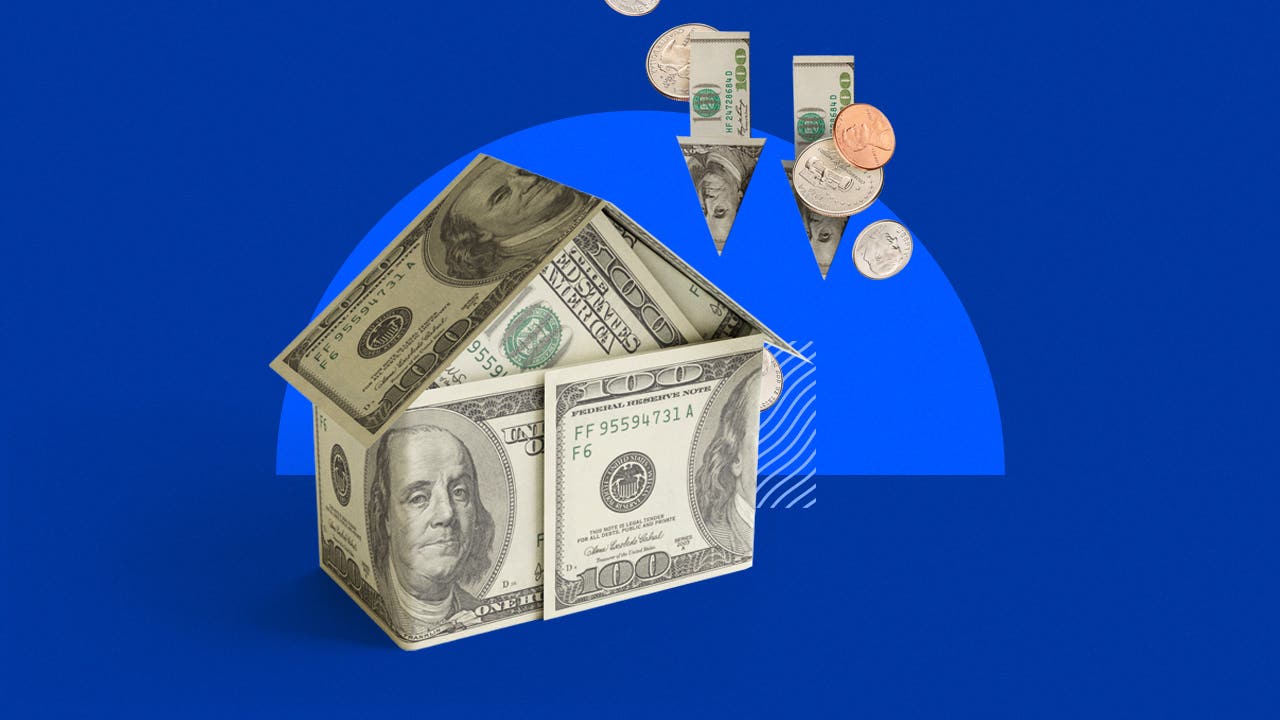What happens to HELOCs if home values fall?

The Bankrate promise
At Bankrate we strive to help you make smarter financial decisions. While we adhere to strict , this post may contain references to products from our partners. Here's an explanation for .
Key takeaways
- Weakness in the housing market could spur lenders to change the original terms of a HELOC (home equity line of credit) in a way that they can't with mortgages.
- A serious dip in home values can cause lenders to lower your credit line or freeze it — preventing you from withdrawing more funds — or even demand full repayment.
- While such changes in your HELOC are unlikely, it's smart to have a backup plan in case you can't withdraw as much money as your lender originally approved.
It’s a new year, but nearly the same old song. The 2024 housing market retains many of the difficult conditions of 2023: continued inventory shortages, high prices and elevated mortgage rates (declining somewhat of late, but still high compared to the low-low rates of just a few years ago).
As a result, many homeowners are choosing not to move and to renovate instead, financing the work by opening a home equity line of credit (HELOC). The run-up in real estate prices of the last few years has made homes a rich source of cash. However, the growth in home price appreciation is slowing — to less than 3 percent by some forecasts — and in some parts of the country, home sales and prices are even declining, particularly in some overheated markets in the West and the South.
A decline in home values can make HELOC lenders nervous — because the home serves as collateral for the line of credit. When residential real estate prices collapsed during the Great Recession, lenders abruptly closed, cut or froze previously approved lines of credit, leaving HELOC owners out in the cold.
Could that happen to your HELOC if the real estate market crashes, or even just cools? Let’s find out.
How do home values affect HELOCs?
A HELOC is a revolving form of credit with a variable interest rate. When you’re approved for a HELOC, your lender sets a credit limit based on your available home equity. Typically, you can borrow up to 85 percent or 90 percent of your home’s value, minus outstanding mortgage balances.
You can calculate your maximum HELOC borrowing amount with this equation:
Say your house’s value is $400,000 and your bank allows you to tap 90 percent of your equity. That means you could run your total debt on the property up to $360,000. If you owe $200,000 on your mortgage, you could have a credit line of $160,000 with a HELOC:
Of course, you don’t have to take the entire amount at once. Often, borrowers use a HELOC as they do a credit card: They tap some of their credit line and then pay it back, sometimes re-borrowing more funds, but never maxing it out. Still, a drop in home value means a drop in the available amount you could withdraw.
How would a housing market crash impact my HELOC?
The country seems to have navigated through the inflationary conditions of the past few years without experiencing a recession thus far. And the odds of one taking place between now and December 2024 have declined to about 45 percent, according to Bankrate’s latest quarterly Economic Indicator Survey. Most economists also agree that a housing market crash isn’t likely and anticipate any retrenchment by HELOC lenders to be mild.
Still, the 2024 residential real estate market is starting off on uncertain ground, and could move in unpredictable ways. If you have a HELOC and the value of your home tumbles, you should be prepared for a few different scenarios.
Your HELOC limit can be lowered
If you haven’t tapped the full amount of your HELOC and home values in your area start dropping, lenders might begin adjusting the amount of your equity based on your place’s new worth. That’ll affect your credit limit. Don’t be surprised if your lender reduces the amount of home equity you can borrow against in line with your home’s new, lower value.
Let’s say, using the example above, your home’s value has declined 10 percent, to $360,000, and you still owe $200,000 on your mortgage. Your equity stake is now worth less, and so you have less tappable equity. So the lender resets your line of credit maximum, reducing it from $160,000 to $124,000.
Your HELOC could be frozen
Your lender could institute a HELOC freeze — that is, limit you to what you’ve already borrowed, regardless of the total amount of your line of credit.
Say you opened the HELOC to pay for a major kitchen renovation costing $100,000. If you tapped the credit line in one gulp, there’d be no change to your loan amount or payments: “If you’ve already drawn the [entire] HELOC, you’ll just keep paying as agreed,” says Ellen Steinfeld, senior executive vice president and head of Consumer Lending and Payments for Berkshire Hills Bancorp in Boston.
However, let’s say you’d withdrawn only $50,000, planning to pay the contractor half the fee upfront, and the other half upon the job’s completion. If you’ve left a big chunk from your line of credit unused, a freeze would effectively prevent you from taking out any more funds.
You could have to pay your HELOC in full
Most drastic of all: Your lender closes your credit line, and demands repayment immediately and in full.
A HELOC is a callable loan, meaning your lender could request that you repay some or all of it at any time. While that could theoretically happen if the residential real estate values plummet (as they did during the Great Recession), it’s more likely to occur only if you regularly miss payments. “As long as you adhere to the agreed-upon repayment terms, a decrease in home values alone does not trigger a demand for immediate full repayment of the borrowed amount,” says Matt Dunbar, Churchill Mortgage‘s senior vice president of the Southeast.
Borrowers worried about defaulting — essentially, not being able to repay what they borrowed — should talk with their lender to avoid this scenario, as it could result in the home being foreclosed upon.
Some lenders may decide to cap the amount of the HELOC you can use.
— Ellen SteinfeldSenior executive vice president, Berkshire Bank
Advantages of HELOCs
HELOCs have grown more popular in recent months for a simple fact: The sharp run-up in mortgage rates in recent years means another common way of tapping equity, the cash-out refinance (a newer, bigger mortgage), is no longer so appealing. Homeowners who are paying 3 to 5 percent on their mortgages currently don’t want to surrender them for a more expensive mortgage that could charge over 7 percent. HELOC rates run a little higher (above 9 percent currently) than refis, but you’re paying interest on a smaller sum — and of course, you get to keep your old mortgage with its low-low rate.
Other advantages of HELOCs include:
- They have slightly lower upfront costs than home equity loans and lower APRs than credit cards.
- You can borrow more money as you need it rather than receiving a lump sum; you’re only charged interest on what you actually withdraw.
- If you’re using your HELOC for home renovations or repairs, the interest may be tax-deductible.
- Repayment options can be more flexible than other lines of credit, with many lenders allowing interest-only payments during the draw period (usually, the first 5-10 years of the loan).
Disadvantages of HELOC loans
However, HELOCS do have their downsides. Some of the biggest disadvantages include:
- HELOC rates are typically variable, so they can rise, increasing your monthly payments.
- Like home equity loans, HELOCs require you to use your house as collateral, putting it at risk of foreclosure if you default.
- There’s the temptation to overspend during the draw period and make interest-only payments — leading to a big jump in your monthly bill when the repayment period begins.
How homeowners can cope with HELOC changes
HELOCs remain a favorable way to pay for home remodels or repairs — they’re certainly a better play than running up credit card debt — but be aware of trends in residential real estate, especially in your local market. If you’re using a HELOC to borrow against your home’s equity, a significant decline in home values could cause your lender to reduce your line or freeze it — as some homeowners learned during the Great Recession.
It’s not as likely to happen nowadays. “Lenders have built in a bigger margin of safety, often requiring homeowners to retain a 10 percent to 20 percent equity stake,” says Greg McBride, Bankrate’s chief financial analyst. “But if home prices have a sustained slide, they’ll be quick to cut or freeze home equity lines as we saw in 2008.”
So how can homeowners cope? “To effectively manage changes to a HELOC, homeowners should adopt a cautious approach to borrowing. It’s wise to only borrow what is absolutely necessary and what can be comfortably repaid without financial strain,” says Dunbar.
You might also consider an alternative type of financing, such as a home equity loan. Unlike a HELOC, a home equity loan allows you to borrow a set amount all at once and then repay at a fixed interest rate, so the lender can’t adjust the amount of equity you can tap should home prices fall.
Final word on HELOCs and falling home values
Ultimately, Steinfeld doesn’t expect a repeat of the HELOC chaos that accompanied the global financial crisis of 2008. During that kickoff to the Great Recession, lenders abruptly froze and even called in HELOCs, a move that took borrowers by surprise. “One of the problems [back then] was a lack of communication,” she says. Today, if the housing market does take a turn to the extent HELOCs are affected, “we would be educating borrowers that we could cap the line.”
The bottom line, though, is that a HELOC comes with strings attached, and a prolonged or severe weakness in the housing market could spur lenders to change the original terms of the loan in a way that they can’t with mortgages. Because of this, it’s smart to have a backup plan — especially if you’re in the midst of a major home renovation project — in case you can’t pull out as much money as your lender originally approved.
Related Articles



